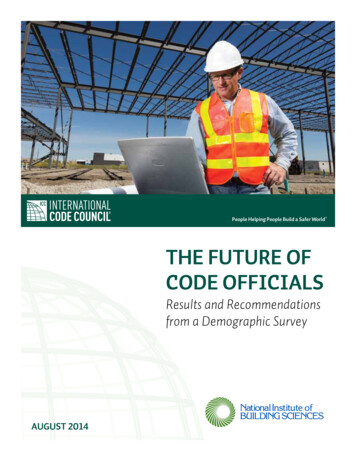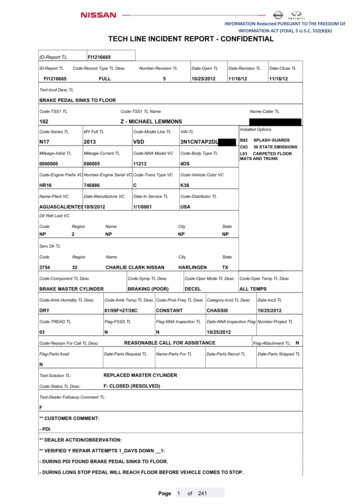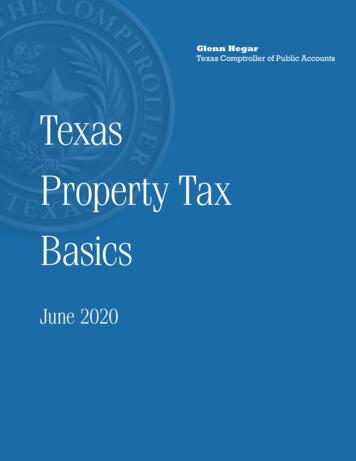
Transcription
People Helping People Build a Safer World The Future ofCode OfficialsResults and Recommendationsfrom a Demographic SurveyAugust 2014
The Future of Code OfficialsResults and Recommendations from a Demographic SurveyintroductionFor more than a century, jurisdictions across the United States have implemented building codes to protect thehealth, safety and welfare of their communities. As communities have recognized the impact buildings have onsustainability and resilience goals, the scope of building codes has expanded.To be effective, codes must have both a robust development process and an enforcement infrastructure.America’s code administration and enforcement professionals serve as the backbone of such a code developmentand enforcement process. However, there is a growing concern among code developers and the building industry atlarge that demographic shifts in the makeup of the code-related workforce will challenge the current buildingregulatory system.These concerns largely grew out of on-the-ground observation by code officials—department staffs were gettingolder, without additional younger participants entering the job pool, and participants at professional organizationand code development meetings were generally older. The International Code Council (ICC), a model code developer and advocate for the adoption of codes leading to safe and healthy communities, wanted to take action toaddress these important issues. However, to help validate these initial observations, and to support a wellinformed response to these perceived threats, more concrete information was needed. The ICC approached theNational Institute of Building Sciences, a non-profit organization established by the U.S. Congress to work acrossthe many stakeholders within the built environment, to assist in this effort.As the first step, the Institute surveyed code officials to determine the current state of the profession, theeducational and career pathways for entering the profession as well as retirement expectations of current codeprofessionals. Following the compilation of survey results, the Institute will develop a summit to bring togetherleaders from the code profession; stakeholders who rely on the existence of a robust workforce of code officials; andother building industry representatives to discuss the findings and offer recommendations for addressing identifiedissues.The Institute conducted the survey from March 17 to May 15, 2014. The Institute sent requests to participate toprofessionals in code administration and enforcement through invitations, newsletters and press releases. Thesurvey received 3,850 responses, with representatives from all 50 states, Australia (2), Canada (3) and India (4).A copy of the survey questions is available in Appendix I of this report.In general, the survey results confirmed the observations of code organizations and on-the-ground code officials.However, there are a few unexpected results that highlight areas where the ICC and others may wish to focusefforts to attract the next generation of code officials. This survey did not address issues of diversity (either bygender or ethnicity), which are certainly related to the development of a robust workforce. However, for thisparticular effort, it was determined that understanding the educational pathways and retirement plans of thecurrent cadre of code officials was fundamental, with diversity issues to be addressed at a town hall meeting inSeptember 2014 and in future research efforts.Page 1
The Future of Code OfficialsResults and Recommendations from a Demographic SurveyThe “Typical” Code ProfessionalWhile it is unlikely that any respondents fit the description of a “typical” code professional exactly, understandingthe most common attributes of a code professional may help bring clarity to the discussion of issues and theensuing recommendations. As indicated previously, the survey did not cover gender or ethnicity.The typical code professional is between the ages of 55 and 64 (See Figure 1). He works at the local level as a jurisdiction employee (rather than a third-party provider) in a one- to nine-person department that serves a communityof less than 75,000 people. He earns an annual salary of between 50,000 and 75,000. He has between 26 and35 years of experience within the building industry, but only five to 15 years spent as a code official. He entered thecode profession while in his 30s, and held between one and three jobs before becoming a code professional. Hisfirst job was as a tradesperson.He may possess a bachelor’s degree (27 percent) or may not have pursued additional education beyond high school(25 percent). If he earned a bachelor’s degree, it is probably in engineering but it could be in some form of business(management, accounting, finance, etc.). He currently does not hold any trade licenses, but does have a professional license, certificate, certification or other credential. His most likely reason for pursuing a job as a code officialis job security, with other reasons such as salary/benefits and respect for the profession also high on the list.His current role in building regulation is as an inspector (general, building or residential), plan reviewer or indepartmental management. Given the relatively small size of the typical department, it is not surprising that hemay serve in some or all of these roles simultaneously. Finally, he expects to leave the building regulatoryprofession within the next five to 15 years (See Figure 2).Figure 1: Age of Respondents0.1%18 to 240%0.1%3.3%25 to 343.3%12.3%35 to 4412.3%45 to28.8%5465 to 749.0%0.9%75 or older0.9%tion, 3.0%icration,ment,%0%0%4%4%14%45.6%9.0%stems,0%82% 14%31%28.8%55 to 64ng, 1.4%Figure 2: Plans to Leave theBuilding Regulatory ProfessionPlanning, % 14.4%82%51%Educ445.6%Less than 5 years16 to 25 years36 to 45 yearsArchitecture,15.5%31%5 to15 yearsLessthan5 years16 26to 25yearsto 35years36 46to 45yearsyearsor more5 to 15 ye26 to 3546 ionalDegree23%16%Associate'sDegree23%Education, g,30.0%Page 2Engineering, Graduated30.0% high school25%Graduatedhigh school25%Bachelor'sExcitinBachelor's
The Future of Code OfficialsResults and Recommendations from a Demographic SurveyKey Results and AnalysisWhile the survey reveals many important pieces of information about the code professional workforce, two datapoints are worth highlighting from the very beginning—retirement expectations and educational backgrounds.An Aging WorkforceIt comes as little surprise that the current workforce is aging and making plans for retirement. However, the actualnumbers are a bit alarming. Nearly 85 percent of the respondents are currently over the age of 45 (See Figure 1,Page 2). More importantly, more than 80 percent of the existing code professional workforce is planning on retiringin the next 15 years, with more than 30 percent in the next five years (See Figure 2, Page 2). The impact of suchretirements may be exacerbated by the small size of most code departments—a third of which have one to fourmembers and more than half have nine or fewer members. While other findings from the survey may temper suchalarm, the fact remains that a significant number of code professionals will be leaving the workforce without anequivalent number of younger professionals already involved in the profession to take their place—only about15 percent of the respondents are under 45 years old, with only about three percent under 35. The retirement ofmultiple members in such a department over a short timeframe would result in a significant loss of institutionalmemory and capacity.Multiple Paths to the ProfessionThe range of educational pathways that current code officials have taken to become code officials is quite interesting. In developing the survey, the survey team anticipated that most of the respondents would have enteredthe code professions through building-related educational programs. While this was true in the majority of cases,educational experience in seemingly disconnected fields—particularly business-related programs (business,management, administration, finance, etc.)—was significant. More than 27 percent of the total respondentsreported earning a bachelor’s degree, with 27 percent of them holding business-related degrees. Only engineeringdegrees were cited more often, with 30 percent (See Figure 3, Page 4).This finding suggests that introducing codes (and the related topic of standards) into the curriculum of businessschools may be a means for actively introducing building regulatory careers to a new group of students. Such anapproach would have the added benefit of highlighting the roles of codes and standards and code departmentsin business decision making. It could also help facilitate attempts by code departments to shift from a perceivedadversarial process to a more cooperative engagement with the design, construction and overall businesscommunities.Additionally, this result may suggest that effective code professionals may find skills beyond understanding designand construction processes valuable. While not covered in this survey, it may be worthwhile to explore how thevarious educational paths (along with other additional training programs) have prepared code professionals fortheir day-to-day functions. The results of such an exploration could assist training and certification programs infocusing in on the most valuable and effective information.Page 3
35 to 4412.3%8214%45 to 5428.8%55 to 64The Future of Code Officials65 to 749.0%75 or older0.9%45.6%Results and Recommendations from a Demographic SurveyFigure 3: 4-Year/Bachelor’s Degree Program CompletedLess than 5 years16 to 25 years36 to 45 yearsArchitecture,15.5%Planning, s,3.0%Technical,Vocational16%Education, g,30.0%0%Business, 26.6%Graduatedhigh school25%0%PublicAdministration AdvancedSome %More than a quarter of code professionals hold bachelor’s degrees (27 percent). High school diplomas(25 percent)7%EducationSystemsInspection, Draftingmain ociate’s45.6% follow closely behind as the Codes4% degrees (232%3%percent). Technical or vocationaldegrees were4% programs were cited by 6 percent of the respondents and advancedFire Science,earned by almost 9 percent (See Figure 4). Figures 5 through 7 (on Page 5) feature the breakdownof program areasSystemsLess than 5 years5 to 15 yearspursued within the other educational pathways.10%16 to 25 years26 to 35 yearsHVACBusiness36 to 45 years46 years or more Building,17%14%ConstructionFigure 4: Educational spection16%Plumbing22%4%Graduatedhigh school25%Engineering,30.0%.6%FireSystems2%Some highschool1%Fire Page 4Trades13%Exciting workenvironment, 16.4%Engagements with codeofficials, uesuggestion, 25.1%Respect for the profession, 35.9%Job security, 48.2%Salary/benefits, 43.7%
5 or older0.9%Administration,Government,6.0%Business, 26.6%16 to 25 yearsGraduated36 to 45 yearshigh school25%Engineering,30.0%Architecture,15.5%The Future of Code OfficialsPlanning, 1.4%Results and Recommendationsfrom a Demographic ,14.4%Education, 3.0%Figure 5: Technical/Vocational ProgramsInspection, rpentry31%Fire onstructionAdvancedSome s,InspectionFigure 6: 2-year/Associate’s Degree ProgramArchitectural16%Fire uction20%Management21%Engineering,30.0%Business, 916%30-39PublicFigure 7: Advanced Degree Education4%22.4%ArchitecturalTechnology 35.0%16%40-49Trades13%50-59Architecture26%60-6970 and ection, .0%Technical,VocationalSome highschool16%26 to 35 years46 years or more28.1%1.7%Engineering12.9%Technology20%0.0%Less than 25,000/yearEngineering27%3.9% 25,000 to 49,999/year21.8% 50,000 to 74,999/year41.3% 75,000 to 99,999/year 100,00 to 124,999/yearPage 5Exciting workenvironment, 16.4% 125,000 to 149,999/year21.2%7.7%2.9% 150,000 to 174,999/year0.7% 175,000 or more0.7%Prorevi
%eThe Future of Code OfficialsResults and Recommendations from a Demographic SurveyAge andPublic Experience20-2922.4%AdministrationAs discussedthe ages of 55 and 64 and another 29 percent3% previously, 45 percent of respondents were between30-3935.0%were younger than 44 years old. While theseLawresults 2%may be disconcerting,based on the ages of current code40-49professionals when entering the28.1%field, there mayPlanning7% experienced members of the workforce into the profession. Nearly 35 percent of surveyEducationstill be hope for bringing4%50-5912.9%respondentsentered the profession in their thirties, and another28 percent while intheir forties (See Figure 8).Less than 5 y5 to 15 yArchitectureEngaging today’s mid-career professionalsin code-related jobs may be possible as a temporary stop-gap measure.60-691.7%26%However, such an approach could potentiallyslow the integration of emerging technologies in transforming thestcode regulatory70 and up needs.0.0%Businessprocess to meet 21 century design and construction14%Figure 8: Age Upon Entering the 7%40-4960-69 25,000 to 49,999/yearLess than 5 years2.9% 50,000 to 74,999/year35.0%28.1%50-5926 to 35 yFigure 9: Respondent SalariesLess than 25,000/year 75,000 to 99,999/year5 to 15 years 100,00 to 124,999/year12.9%1.7% 125,000to 149,999/year16 to 25 years70 and up 0.0%Exciting workenvironment, 16.4%Engagementswith codeProfessionalSalariesLess than 25,000/year3.9%officials,18.0%3.9%9.9%46 years or m21.2%15.6%30.8%21.8% Product sales/de2.9% 150,000 to 174,999/year0.7%26 to 35 years 175,000 or more0.7%36 to 45 years36 to 45 y21.8%41.3%7.7%16 to 25 y14.9%1.8%Code inspreviewer/code33.2admConstruct22.3%The mediansalaryfor those code officials 21.8%polled was between 50,000 and 74,999 per year (See Figure 9). ThisFriend/family/colleague 25,000to 49,999/yearsuggestion,25.1%range remainedconsistent across the age of the respondents and their number0.2%of years of experience as a code pro 50,000 to o the seniority of the current4.1%Respectfor the(thusprofession,35.9% any concern that the salary numbers are artificially high dueworkforce).Therealso appears to be a sizablerespondents 75,000to 99,999/year21.2%opportunity for salary growth, as one fifth of theCodeProfession earnJobbetweensecurity, 48.2% 75,000 and 99,999 annually. Compared to the median household income of 51,017 reported by the 100,00 to 124,999/year7.7%ArchitecTraBuilding InU.S. Census Bureau for 2012, code officials can earn a respectable living. This point should be highlighted as one ofSalary/benefits,43.7%33.2%of the respondents cited 125,000 149,999/year2.9%the reasonstotoconsidera career asa code professional (SeeFigure10, Page 7). In fact, t behind job securityas one of the main reasons they pursued a career as a code professional. 150,000 to 174,999/year23.9%0.7%DepartmeCode inspector/plan23.7%As identified 175,000in the keyfindings, most respondents (47 percent)beganin the trades and almost another quarter (24reviewer/codeadministratoror more0.7%12.5%percent) immediately started their career as a code professional (See Figure 11, Page 7). A number of respondents9.7%Construction/project12.3%skipped this question, however, which may indicate that their first payingmanagerjob was not in a building-relatedcareerat all (this may be foreshadowed in Figure 3 on Page 4, showing the educational pathways they pursued). In future31.2%1 to 45 to13.4%9 and, specifiArchitect/engineerstudies and surveys, the ICC may wish to examine these alternativepathways tothe building industry10 to 1428.4%cally, code-related careers in-depth.15 to 24Trades personWhile in general, current code professionals are familiar with the buildingindustry, with a majority having over 2514.1%years of experience (60 percent), their experience as code professionals is of significantlyless duration—only 17Communitipercent had more than 25 years’ experience (See Figure 12, Page 7). Coupled with the age demographics,this tends7.8%6.9%33.2%to suggest that becoming a codeprofessional is a career change made later in a person’s overall career. Prior to2.4% 2.2%becoming a code professional, however, a vast majority of respondentswere in stable jobs, with 59 percent holdingDepartments3.7%23.9%just one to three different positions (28 percent held four to six previous jobs; 11 percent held 7 or more).12.5%Page 6 9.7%31.2%28.4%1 to 45 to 910 to 14Insp8.4%12.3%InspInspe
25,000 to 49,999/year27%17%Associate'sDegree23% 50,000 to 74,999/year 75,000 to 99,999/year22.4%The Future of Code Officials 100,00 to 124,999/year9.9%Results35.0%and RecommendationsLess than 5 yearsfrom a Demographic Survey2.9%28.1%.9%Bachelor'sFigure 10:DegreeReasonsfor27%Pursuing Careeras Code Professionalncedree%r21.8%rrre 175,000 or .1%26to 35 years14.9%33.2%22.3%334.1%21.2%rrEngagements16to 25 years with codeofficials, 18.0%0.2%46 Salary/benefits,years or more 43.7%41.3% 150,000 to42.5% 174,999/year15.6%Respect for the profession, 35.9%1.8%36 to 45 yearsJob security, 48.2%3.9%r5 to 15 yearsExciting workenvironment, 16.4% 125,000 to 149,999/yearCode ProfessionBuilding Industry7.7%Figure 11:2.9%ConstructionFirst Paying JobManagement0.7%21%0.7%Product sales/development4.0%Code inspector/planreviewer/code ralTechnology16%31.2%23.7%1413.4%Trades personProfessions12.9%1 to 45 to 96.9%21.8%earearearear10 to 1421.2%46.6%Less than 5 yearsDepartments9.9%2.9%5 to 15 years9.7%8.4%15 to 2425 to 49Inspector (Fire)30.8%Inspector (Plumbing)21.8%50 or moreCommunities36 to 45 years2.4% 2.2%3.7%46 years or more41.3%0.9%Inspector (General)42.5%Inspector (Building)15.6%12.3%16 to 25 years26 to 35 years14.1%ear3.9%7.8%earear12.5%Inspector (Energy)14.9%33.2%Inspector(Mechanical)Inspector (Boiler)1.8%22.3%Inspector (Elevator)4.1%0.9% 1.6%Inspector (Rental)Building IndustrySpecial InspectorCode Profession0.7%Plan ReviewProduct sales/developmentCode inspector/plan4.3%2.0%Inspector eeringhnology 22.4%20%33.2%Figure 12:35.0%Time in Building23.9%andCodes28.1%28.4%Page 74.0%Department Management23.7%Other3.5%
50-5960-695 to 15 years12.9%1.7%16 to 25 yearsThe Future of Code Officials70 and up15.6%21.8%0.0%Results and Recommendations from a Demographic Survey26 to 35 yearsLess than 25,000/year3.9%36 to 45 years 25,000 to 49,999/year21.8%Code Departmentsand Communities14.9%1.8%22.3%0.2% their work environIn additionto understandingthe demographics of individualcode professionals,understanding 50,000to 74,999/year46 years or more41.3%4.1%ment is important for attracting and retaining the future workforce. While the survey did not proberespondents’ 75,000to 99,999/year21.2%Code areProfessionattitudes toward their work environment, it did capture information about where future code professionalslikely to 100,00be needed.to 124,999/year7.7%As previously identified, most departments are very small (a third house between one and four staff; nearly a quarter 125,000 to 149,999/year2.9% raise concerns about theProductsales/development4.0%have between five and nine). These findingsabilityto replace senior staff; opportunitiesformentoringnew entrantsinto the gewhenstaffretires.One 150,000to 174,999/year0.7%Codetoinspector/planpotential benefit of bringing new professionals into small offices is the abilityupdate technologies and practices inreviewer/codeadministrator 175,000ormore0.7%conjunction with the change in personnel, thus limiting disruption in the existing workforce. Model code developers,code professional organizations, building information modeling (BIM) advocates,smart city product providers andConstruction/project12.3%other stakeholders may wish to come together to work collectively in realizing such managera cross-industry transformation.Architect/engineer13.4%Trades personFigure 13: Size of Communities and Departments33.2%Departments23.9%12.5%31.2%28.4%1 to 45 to 910 to 1414.1%7.8%9.7%8.4%15 to 2425 to 4912.3%50 or moreCommunities6.9%2.4%Page 82.2%3.7%0.9%0.9%1.6%23
15.6%21.8%30.8%The Future of Code Officials14.9%33.2%Results and Recommendationsfrom a Demographic Survey22.3%The relatively small size of building departments reflects the size of the communities they serve (See Figure 13,Page 8). Nearly 60 percent of the respondents’ communities have less than 75,000 residents, including 31 percente Profession under 25,000. BuildingIndustrynew technologies in these small communities may be difficult given budget conImplementingstraints. Demonstrating the value such transitions may provide would be necessary to facilitate such changes.Communities may consider utilizing third-party providers to fulfill some or all of the roles previously conducted byretiring code professionals. The survey revealed that only five percent of respondents are third-party providers, butit did not capture information on the trends related to the use of third-parties. This may be an important area toexamine in subsequent surveys.23.7%Within departments, code professionals fulfill a variety of roles. Given the size of departments and the number ofareas covered, many professionals have responsibility in numerous areas. Over half of the respondents (52 percent)12.3%had responsibility for plan review, with over 48 percent serving as building inspectors and 46 percent in departmentmanagement (respondents could select as many roles as applied to them). In-depth analysis reveals that 71 percent13.4% of the respondents who conduct plan reviews are also building inspectors; 66 percent are residential inspectors;58 percent are mechanical inspectors; 56 percent are general inspectors; 51 percent are plumbing inspectors; 50percent are energy inspectors; and 48 46.6%percent serve in department management. This tends to suggest that planreview is not a separate specialized function, but is often included in the responsibilities of inspectors.Figure 14: Roles in Building Regulation38.1%Inspector (General)48.3%Inspector (Building)19.1%Inspector (Fire)34.6%Inspector (Plumbing)30.0%Inspector (Energy)38.3%Inspector (Mechanical)Inspector (Boiler)Inspector (Elevator)4.3%2.0%44.0%Inspector (Residential)12.6%Inspector (Rental)Special Inspector3.5%Plan Review51.8%Department Management45.8%Other22.3%Page 9
The Future of Code OfficialsResults and Recommendations from a Demographic SurveyAdvice to the Future Code ProfessionalIn addition to demographic questions, the survey asked respondents to provide advice to high school students whomay be considering a career as a code professional. More than 2,650 of the respondents provided advice, rangingfrom positive messages about joining the profession to negative recommendations to avoid entering the field.While negative comments did exist, the overwhelming majority of comments were positive.Most of the responses focused on the value of education beyond high school—either in the trades or in an architecture, engineering or construction management program—and the importance of obtaining experience as atradesperson, construction manager or designer. The value of certification and continuing education was highlightedfrequently. Several respondents commented on the political nature of the position; some emphasized the need tobe prepared for such realities; and others suggested the profession be avoided because of politics and bureaucracy.Comments representing the most common messages are featured below:“Extremely rewarding, always helping people, always learning, never a dull moment, always indemand. If you stop and think about the inspection you just performed, the plans you justreviewed or the complaint you just settled, you can consider yourself a pre-first responder.”“Get all of the vocational training you can, and work in the building trades field, so you have a goodunderstanding of how a structure should go together. Work for a good, reputable contractor for atleast two years and train, train, train.”“This is an exciting, steady and rewarding career. For those that are either interested in the tradesor being a professional engineer, building inspection and building department administration canbe far more rewarding, as you maintain vigilance over all structures built in your jurisdiction toensure they meet the minimum standards of the laws and codes.”“Research and understand the job responsibilities of a code admin and enforcement professional.Get a job that provides hands-on experience within one or two construction related fields, suchas framing and concrete. Research and study the code books. Become familiar with procedures ofconstructing a building. Learn the nomenclature. Stay current on both current trends and thefuture direction of construction. Read, study and speak with people with long careers to gainadvice and perspective. Never stop learning.”“Find something else. The politics of a local municipality are not worth the trouble.”“I believe that my 25 years in the field of commercial construction as an apprentice, journeyman,foreman and supervisor served me well when I made the decision to enter the inspection field.Some field experience as a tradesman or field supervisor is very important.”Page 10
The Future of Code OfficialsResults and Recommendations from a Demographic SurveyWhile the vast majority of respondents focused on advice to students who may be considering pursuit of a career asa code professional, some offered additional comments that may influence future efforts to attract new entrants:“I would actually like to give advice to the building inspection departments around the country:get more involved in educating the high school students in what we do and have an open mind inregards to allowing drive-alongs for students/people interested in this profession. I was certifiedas an inspector for five years before I was finally blessed to be hired as one. In those five years, Icould not get any building department to allow me to go on a drive-along with an inspector.”“Invest in having more females in this industry by either mentoring or hiring interns (if possible).During college, I mentored high-risk grade and high school students to become more interested inarchitecture. Hopefully this had an impact.”“Pay vs. Responsibility is currently totally unbalanced. Pay needs to increase to get qualifiedpeople.”“An active program of public education on the importance of life safety codes should be designedto encourage compliance with safety laws and sensitivity of unsafe conditions. An informed publicfacing a life-threatening situation is far more capable of taking appropriate action.”“It would be helpful to get the trade schools involved with an incentive program or have a courseavailable to show the students in the trade schools what it is that code officials do. The class couldincorporate the local building officials’ chapters for assistance. Promote membership.”“Provide code books to them at no charge; have them read it in class; discuss what it means; testthem on it; and then implement code readings during workshop projects or the field to physicallysee it in action. Teach the right and wrong ways to comply with the codes. And, most of all, takethe politics out of the code process. Outside interference from people or agencies that do not knowthe importance of the codes should stand aside. Let us do our work!”“Code officials need to take more care in fostering and promoting the need for building codeswith the associated professions, including builders and designers, and especially with the electedand appointed officials that employ them. ICC needs to do the same, for that matter. The generalpublic could care less about codes and ICC will never be a household name. But working closelywith other stakeholders and policy makers at a sustained level is critical to explaining not only thesafety benefits, but the economic benefits as well. Maybe after a while, the title "Building Official"or "Building Inspector" will draw its own students based on a level of professionalism, known andcommunicated benefits, and hopefully a sustainable middle-class wage.”Page 11
The Future of Code OfficialsResults and Recommendations from a Demographic SurveyAppendix iCode Official Demographic SurveyThere is growing concern within many sectors of the building industry that an insufficient number of new participants are entering the buildingsworkforce. Code officials and others that serve the building regulatory segment of the industry in particular are concerned.On behalf of the International Code Council, the National Institute of Building Sciences is conducting a nationwide survey of participa
National Institute of Building Sciences, a non-profit organization established by the U.S. Congress to work across . code profession while in his 30s, and held between one and three jobs before becoming a code professional. His . Electrical 21% Plumbing 22% Carpentry 31% Inspection, Codes 4% Drafting 3% Fire Systems 2% Construction Management











